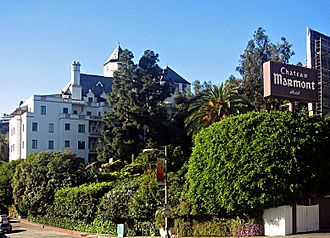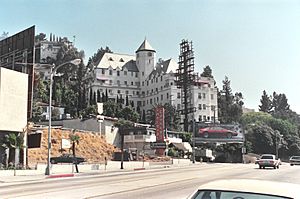Chateau Marmont facts for kids
Quick facts for kids Chateau Marmont |
|
|---|---|

View of the Chateau from Sunset Boulevard
|
|
| General information | |
| Location | Los Angeles, California |
| Address | 8225 Marmont Lane and 8221 Sunset Boulevard Los Angeles, California |
| Coordinates | 34°5′53″N 118°22′07″W / 34.09806°N 118.36861°W |
| Affiliation | André Balazs Properties |
| Design and construction | |
| Architect |
|
| Other information | |
| Number of rooms | 63 (rooms, suites, cottages, and bungalows) |
| Number of restaurants | 1 |
| Number of bars | 1 |
The Chateau Marmont is a famous hotel located at 8221 Sunset Boulevard in Los Angeles, California. Architects Arnold A. Weitzman and William Douglas Lee designed the hotel, which was finished in 1929. It was inspired by the Château d'Amboise, a royal castle in France's Loire Valley.
The hotel is well-known as a place where celebrities often stay, both for short visits and longer periods. Many famous people have called it a temporary home. The Chateau Marmont has 63 different places to stay, including regular rooms, suites, small cottages, and bungalows.
Since 2020, the Chateau Marmont has become a hotel where only members can stay.
Contents
History of Chateau Marmont
Building the Chateau
In 1926, Fred Horowitz, a well-known lawyer in Los Angeles, chose a spot at Marmont Lane and Sunset Boulevard. He wanted to build an apartment building there. Horowitz had recently traveled to Europe and brought back pictures of a Gothic-style castle along the Loire River in France.
In 1927, Horowitz asked his brother-in-law, Arnold A. Weitzman, to design the building. Weitzman was an architect trained in Europe. He based the seven-story, L-shaped building on Horowitz's French castle photos. They thought about names like Chateau Sunset or Chateau Hollywood. But they decided on Chateau Marmont, named after the small street in front of the property.
On February 1, 1929, the Chateau Marmont opened its doors. It was Hollywood's newest and most exclusive apartment building. Local newspapers said it was "superbly situated," meaning it was close to businesses but far enough away for peace and quiet. Over 300 people, including reporters, came to the opening party.
Becoming a Hotel
During the Great Depression, it was hard for the building to keep tenants because of tough economic times. So, in 1931, Horowitz sold the apartment building to Albert E. Smith for $750,000. Smith was a co-founder of Vitagraph Studios, a film company.
Smith decided to turn the apartments into a hotel. This was a good idea, especially with the 1932 Summer Olympics happening in Los Angeles soon. The apartments became hotel suites with kitchens and living rooms. The hotel was also decorated with old furniture bought from sales during the Depression. In the 1930s, a former silent film actress named Ann Little managed the hotel.
During World War II, the hotel was used as a safe place for people nearby during air raids. From about 1942 to 1963, Erwin Brettauer, a German banker, owned the Chateau. He was known for welcoming all guests, including Black guests. This was important because it helped break down racial barriers in Hollywood and Beverly Hills hotels at the time.
The Chateau Marmont was built to be strong against earthquakes. It survived big earthquakes in 1933, 1953, 1971, 1987, and 1994 without major damage. Nine Spanish-style cottages and a swimming pool were built next to the hotel in the 1930s. The hotel bought them in the 1940s. Craig Ellwood, a famous architect, designed two of the four bungalows in 1956.
New Owners and Improvements
Even though the hotel was doing well, by the 1960s, the building needed many repairs. The owners tried to sell it several times. News articles from the 1960s and 70s described it as an "elderly castle" or "rundown."
After being for sale for two years, the Chateau was sold in 1975. Raymond R. Sarlot and Karl Kantarjian, from a real estate company, bought it for $1.1 million. They planned to add a new part to the hotel. They fixed and improved many parts of the hotel. But they made sure to keep the hotel's original style and history. In 1976, after they started their improvements, the Chateau was named a Los Angeles Historic-Cultural Monument. This means it's an important historical place in Los Angeles. Writer Quentin Crisp praised the Chateau for "avoiding undue modernization" and staying in its "romantic past."
Modern Updates
In 1990, André Balazs bought the hotel. Balazs wanted to make the hotel modern but also keep its special character. For the updates, Balazs wanted it to seem like the hotel hadn't changed much, even though it was being renovated. All the floors were re-carpeted, the walls were repainted, and the public areas were improved.
To keep the hotel and bungalows private, taller fences and coverings were added. This helped stop people from looking onto the grounds.
In 2020, the Chateau Marmont changed to a private members-only hotel.
Dining at the Chateau
The hotel's restaurant terrace serves fresh California cuisine. This means they use local ingredients. The restaurant Bar Marmont closed in 2017.
In July 2018, a new restaurant called Chateau Hanare opened. It is in a building next to the hotel. The owner, André Balazs, had wanted to work with the restaurateur, Reika Alexander, for five years.
Chateau Marmont in Pop Culture
In Movies
The Chateau Marmont has appeared in many movies:
- Director Sofia Coppola filmed her movie Somewhere at the hotel in 2010.
- The hotel also appears in the Academy Award-winning films La La Land (2016) and A Star Is Born (2018).
- Other movies include The Night Walker (1964), The Strip (1951), Myra Breckinridge (1970), Blume in Love (1973), The Doors (1991), Dangerous Game (1993), Laurel Canyon (2003), and Maps to the Stars (2014).
- The first scene from The Canyons (2013) was filmed at the Bar Marmont, which is now closed.
In Books
The Chateau is often a setting in many books:
- Eve Babitz's Eve's Hollywood (1974) and Slow Days, Fast Company (1977).
- James Ellroy's The Big Nowhere (1989).
- Dominick Dunne's An Inconvenient Woman (1990) and Another City, Not My Own (1997).
- Charles Bukowski's Hollywood (1995).
- Lauren Weisberger's Last Night at Chateau Marmont (2010).
- Michael Connelly's The Drop (2011).
- It is also the office of a fictional paparazzo in the web comic The Private Eye.
- In 2019, Shawn Levy published The Castle on Sunset: Life, Death, Love, Art, and Scandal at Hollywood's Chateau Marmont.
In Music
Many songs mention the hotel:
- "Plastic Hearts" by Miley Cyrus from her 2020 album.
- "Dying in LA" by Panic! At The Disco.
- "West L.A. Fadeaway" by the Grateful Dead from their album In the Dark.
- "Off to the Races" by Lana Del Rey from Born to Die. (Lana Del Rey also has a tattoo of the hotel's name).
- "Chateau Lobby #4 (in C for Two Virgins)" by Father John Misty from I Love You, Honeybear (2015).
- "Chateau" by Angus & Julia Stone from Snow (2017).
- "Trigger Bang" by Lily Allen from No Shame (2017).
- "Chateau" by Joshua Radin (2020).
- In 2017, Jarvis Cocker and Chilly Gonzales made an album inspired by the hotel called Room 29.
- The famous album cover for No Love Deep Web by Death Grips was taken at this hotel.
In Art and Fashion
- Actor James Franco made a copy of the Chateau's Bungalow 2 for his art exhibit at MOCA in 2012.
- The hotel's stationery (paper and envelopes) has been used in art by artists like André, Gary Baseman, Robert Gober, Martin Kippenberger, and Claes Oldenburg.
- The Chateau's brand was part of a special clothing collection by the fashion label Gucci in 2018.
Images for kids



